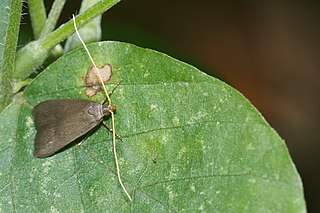Related Research Articles

Silent Weapons for Quiet Wars is the debut from Wu-Tang affiliate Killarmy released on August 5, 1997 on Wu-Tang/Priority Records. The group consists of six MCs: Killa Sin, Beretta 9, Islord, 9th Prince, P.R. Terrorist, and ShoGun Assasson; and one producer, 4th Disciple, who produced the majority of the album. Like Black Lung's album of the same name, the title was taken from a document that came to light in the mid-1980s detailing an alleged New-World Order plan for world domination; a topic that was explored in Milton William Cooper's infamous book Behold a Pale Horse.

The Lecithoceridae, or long-horned moths, are a family of small moths described by Simon Le Marchand in 1947. Although lecithocerids are found throughout the world, the great majority are found in the Indomalayan realm and the southern part of the Palaearctic realm.

Tsuga chinensis, commonly referred to as the Taiwan or Chinese hemlock, or in Chinese as tieshan, is a coniferous tree species native to China, Taiwan, Tibet and Vietnam. The tree is quite variable and has many recognised varieties, though some are also maintained to be separate species by certain authorities. The tree was recently discovered in the mountains of northern Vietnam, making that the southernmost extension of its range.

The Lecithocerinae are a subfamily of small moths in the family Lecithoceridae. They are found worldwide, but most species occur in South Asia. The subfamily is characterized by the male genitalia with a bridge-like structure connecting the tegumen and the valva, and the uncus almost always is vestigal with two lobes at the dorsal base, only exceptionally united into a broad plate, but never as a thorn or spine.
Frisilia is a genus of moths in the family Lecithoceridae. The genus was erected by Francis Walker in 1864.

Lecithocera is a genus of moths in the lecithocerid subfamily Lecithocerinae. The genus was erected by Gottlieb August Wilhelm Herrich-Schäffer in 1853.
Scythropiodes is a genus of moth in the family Lecithoceridae.
Torodora is a genus of moths in the family Lecithoceridae. The genus was erected by Edward Meyrick in 1894.

Wu-Tang Forever is the second studio album of American hip hop group Wu-Tang Clan, released June 3, 1997, on Loud/RCA Records in the United States. Pressed as a double album, it was released after a long run of successful solo projects from various members of the group, and serves as the follow-up to their debut album Enter the Wu-Tang . Forever features several guest appearances from Wu-Tang affiliates Cappadonna, Streetlife, 4th Disciple, True Master, and Tekitha. The original run of compact discs featured an "Enhanced CD" which allowed users to walk around the "Wu Mansion" and access additional content.
Autosticha latiuncusa is a moth in the family Autostichidae. It was described by Kyu-Tek Park and Chun-Sheng Wu in 2003. It is found in Sichuan, China.
Autosticha pentagona is a moth in the family Autostichidae. It was described by Kyu-Tek Park and Chun-Sheng Wu in 2003. It is found in Guangdong, China.
Autosticha sinica is a moth in the family Autostichidae. It was described by Kyu-Tek Park and Chun-Sheng Wu in 2003. It is found in Sichuan, China.
Autosticha taiwana is a moth in the family Autostichidae. It was described by Kyu-Tek Park and Chun-Sheng Wu in 2003. It is found in Taiwan.
Scythropiodes barbellatus is a moth in the family Lecithoceridae. It was described by Kyu-Tek Park and Chun-Sheng Wu in 1997. It is found in the provinces of Jiangxi, Fujian and Anhui in China.
Scythropiodes gnophus is a moth in the family Lecithoceridae. It was described by Kyu-Tek Park and Chun-Sheng Wu in 1997. It is found in Sichuan, China.
Scythropiodes hamatellus is a moth in the family Lecithoceridae. It was described by Kyu-Tek Park and Chun-Sheng Wu in 1997. It is found in Korea and Sichuan, China.
Scythropiodes jiulianae is a moth in the family Lecithoceridae. It was described by Kyu-Tek Park and Chun-Sheng Wu in 1997. It is found in the Chinese provinces of Jiangxi and Sichuan.
Scythropiodes oncinius is a moth in the family Lecithoceridae. It was described by Kyu-Tek Park and Chun-Sheng Wu in 1997. It is found in Hainan, China.
Scythropiodes tribula is a moth in the family Lecithoceridae. It was described by Chun-Sheng Wu in 1997. It is found in the Chinese provinces of Sichuan and Hubei.
Scythropiodes triangulus is a moth in the family Lecithoceridae. It was described by Kyu-Tek Park and Chun-Sheng Wu in 1997. It is found in the Chinese provinces of Hainan, Fujian, Guangdong and Jiangxi.
References
- ↑ Savela, Markku (December 30, 2018). "Scythropiodes elasmatus Park & Wu, 1997". Lepidoptera and Some Other Life Forms. Retrieved November 5, 2019.
- ↑ Insecta Koreana 14
| This article relating to the subfamily Lecithocerinae is a stub. You can help Wikipedia by expanding it. |